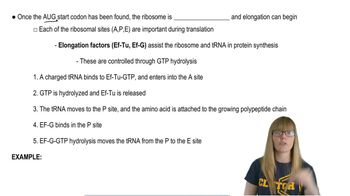Here are the essential concepts you must grasp in order to answer the question correctly.
Transfer RNA (tRNA)
Transfer RNA (tRNA) is a type of RNA molecule that plays a crucial role in protein synthesis by transporting amino acids to the ribosome, where proteins are assembled. Each tRNA molecule is specific to one amino acid and has a unique three-dimensional structure that allows it to recognize and bind to the corresponding codon on the mRNA during translation.
Recommended video:
Recognition Sites
Recognition sites on tRNA are specific regions that facilitate the accurate pairing of tRNA with mRNA and the corresponding amino acid. These sites include the anticodon, which pairs with the mRNA codon, and additional sites that ensure the correct amino acid is attached and that the tRNA is properly positioned for peptide bond formation.
Recommended video:
Tertiary Structure of tRNA
The tertiary structure of tRNA refers to its three-dimensional shape, which is essential for its function. This structure is stabilized by various interactions, including hydrogen bonds and base stacking, and is critical for the proper positioning of the recognition sites. The unique folding of tRNA allows it to effectively interact with both mRNA and ribosomes during protein synthesis.
Recommended video:
 Verified step by step guidance
Verified step by step guidance

